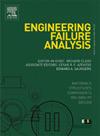Field observations and numerical modeling of the collapse mechanism of the Habibi Neccar Mosque during the 2023 Kahramanmaraş earthquakes
IF 4.4
2区 工程技术
Q1 ENGINEERING, MECHANICAL
引用次数: 0
Abstract
The seismic behavior and collapse mechanism of the Habibi Neccar Mosque—recognized as the first mosque in Anatolia and completely destroyed during the 6 February 2023 Kahramanmaraş earthquakes—were investigated through an integrated methodology comprising field observations, structural modeling, and advanced numerical analyses. The structure was modeled using a macro-scale finite element approach with SOLID65 elements in ANSYS, incorporating the Willam–Warnke failure surface to simulate the nonlinear behavior of masonry components. Material properties were derived from experimental studies on regional stone types and engineering correlations. The first three vibration modes obtained through modal analysis revealed dominant translational and torsional behavior, with the first-mode frequency computed as 5.26 Hz. Pushover analyses indicated direction-dependent lateral load capacities: approximately 18,000 kN in the X direction and 14,000 kN in the Z direction. Nonlinear time-history analyses using unscaled ground motion records from the epicentral region demonstrated that the structure entered a collapse mechanism at a dome displacement of ±15 mm, with maximum base shear forces reaching 10,000 kN. The dynamic strain distributions confirmed the progressive damage initiated at the dome–arch interface, followed by sequential failure of the vaults, portico, and bearing walls. These results exhibited strong agreement with post-earthquake field observations, validating both the structural modeling strategy and the defined material parameters. Furthermore, the analytical outcomes were found to be consistent with empirical displacement-based collapse limits reported in previous studies. This research emphasizes the importance of displacement-based nonlinear analysis methods in assessing the seismic vulnerability of historical masonry mosques. The presented methodology and findings are expected to serve as a reference framework for the structural evaluation, retrofitting, and restoration of heritage structures located in high seismicity regions.
2023年kahramanmaraki地震期间Habibi Neccar清真寺倒塌机制的现场观测和数值模拟
Habibi Neccar清真寺被认为是安纳托利亚的第一座清真寺,在2023年2月6日的kahramanmaraku地震中被完全摧毁,该清真寺的地震行为和倒塌机制通过综合方法进行了调查,包括现场观测、结构建模和先进的数值分析。采用ANSYS中SOLID65单元的宏观有限元方法对结构进行建模,并结合Willam-Warnke破坏面来模拟砌体构件的非线性行为。材料特性来源于区域石材类型和工程相关性的实验研究。模态分析得到的前三个振型以平动和扭转为主,第一模态频率为5.26 Hz。推覆分析表明,侧向载荷能力与方向相关:X方向约18000 kN, Z方向约14000 kN。利用来自震中地区的未标度地震动记录进行的非线性时程分析表明,该结构在穹顶位移±15 mm时进入坍塌机制,最大基底剪力达到10,000 kN。动态应变分布证实了从穹顶-拱界面开始的渐进式损伤,随后是拱顶、柱廊和承重墙的顺序破坏。这些结果与地震后的现场观测结果非常吻合,验证了结构建模策略和定义的材料参数。此外,分析结果与以往研究报告的基于位移的倒塌极限一致。本研究强调了基于位移的非线性分析方法在历史砌体清真寺地震易损性评估中的重要性。所提出的方法和研究结果有望为位于高地震活动性地区的遗产结构的结构评估、改造和修复提供参考框架。
本文章由计算机程序翻译,如有差异,请以英文原文为准。
求助全文
约1分钟内获得全文
求助全文
来源期刊

Engineering Failure Analysis
工程技术-材料科学:表征与测试
CiteScore
7.70
自引率
20.00%
发文量
956
审稿时长
47 days
期刊介绍:
Engineering Failure Analysis publishes research papers describing the analysis of engineering failures and related studies.
Papers relating to the structure, properties and behaviour of engineering materials are encouraged, particularly those which also involve the detailed application of materials parameters to problems in engineering structures, components and design. In addition to the area of materials engineering, the interacting fields of mechanical, manufacturing, aeronautical, civil, chemical, corrosion and design engineering are considered relevant. Activity should be directed at analysing engineering failures and carrying out research to help reduce the incidences of failures and to extend the operating horizons of engineering materials.
Emphasis is placed on the mechanical properties of materials and their behaviour when influenced by structure, process and environment. Metallic, polymeric, ceramic and natural materials are all included and the application of these materials to real engineering situations should be emphasised. The use of a case-study based approach is also encouraged.
Engineering Failure Analysis provides essential reference material and critical feedback into the design process thereby contributing to the prevention of engineering failures in the future. All submissions will be subject to peer review from leading experts in the field.
 求助内容:
求助内容: 应助结果提醒方式:
应助结果提醒方式:


